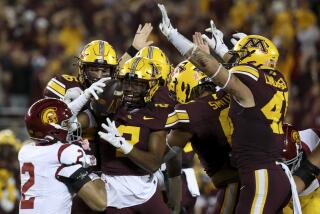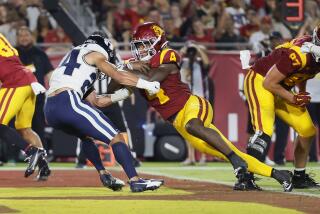How Two Promising Seasons Became. . . : Lost Causes
- Share via
When did things go so terribly wrong for USC?
The easy answer is in the final seconds of the first half Sept. 25 against Oregon, when Carson Palmer lowered his shoulder and you could almost hear USC’s season crack along with his collarbone.
“I think about it all the time, and of course, the team’s consensus is with Carson we’d be 9-1,” safety David Gibson said. “To make it seem positive I’d like to think that, but who really knows?”
The truth is, some of the seeds of USC’s 4-6 record and the five-game losing streak that ended Saturday were sown earlier.
Even with Palmer as a healthy backup last season, the Trojans lost a 21-point lead in a loss to Cal--just as they did in stunning consecutive losses to Notre Dame and Stanford this season.
Even with Palmer, they were prone to penalties and defensive breakdowns--remember the San Diego State Hail Mary touchdown just before halftime this season, which helped turn a blowout into a few tense final minutes?
No, losing their quarterback wasn’t the Trojans’ only problem. It just allowed their other flaws to take root and grow.
Some reach back years and see a decade in which USC, for all its glorious history, has not finished in the top 10 once--and has finished nationally ranked only three times.
There was the recruiting of an offensive line that has never reached the old USC standards, and the hiring almost two years ago of Paul Hackett, a veteran NFL assistant still adjusting to the college game and the demands of being a head coach.
What has made this so difficult is USC believed 1999 would be different.
“I looked at this team in camp and thought, ‘We are going to the Rose Bowl,’ ” offensive lineman Travis Claridge said. “I had no question in my mind.”
Then Palmer was hurt in the Pacific 10 Conference opener against Oregon--a game that ended in a mistake-filled 33-30 loss in triple-overtime.
If Palmer hadn’t lowered his shoulder?
“I think it’d be different, but who knows?” receiver R. Jay Soward said. “People just have to step up, and we didn’t step up when our leader went down.”
The way Soward sees it, that was the day USC’s confidence was crushed.
“That took a lot out of us,” he said. “We get over the hump right there against Oregon and we would have had the momentum. I think the season would have been different, with or without Carson. I think that was the most pivotal game. Everything after that seemed kind of destined.”
The tide turned, and there no turning it back.
“Any time you lose, everything’s magnified,” Gibson said. “And when you’re winning, so many things happen that are overlooked. It’s tough when you lose, because you analyze everything. Sometimes you can over-analyze.”
At the risk over over-analysis, here goes:
Yellow Flags
The astounding 21 penalties against Oregon--a Pac-10 record--showed USC’s true colors.
From false starts to personal fouls and pass interference, the Trojans have been masters of the unnecessary penalty.
With reducing penalties a major focus, the average was whittled to fewer than 10 a game. But even when the Trojans had only three against Notre Dame, one of the three--safety Ifeanyi Ohalete’s personal foul in the second half--sustained a drive that was key to the Irish comeback.
Personal fouls are on the players’ shoulders, but Hackett took blame for some other penalties, including two illegal substitutions against Arizona State in a game in which there were only five penalties.
“We’ve finally got that under control, knock on wood,” Hackett said.
Knock on wood, indeed: USC had 15 penalties for 140 yards Saturday.
Coaching
USC’s season has polarized fans into pro-Hackett and anti-Hackett camps. Make that anti-Hackett camps and give-him-a-little-more-time camps.
At least there’s this: The problems have prompted Hackett to a level of self-examination unseen in his first season, when he was often rigid and defensive. After the misstep this season, when he seemed to be blaming the upperclassman for USC’s problems, he has become almost comically willing to take blame for anything.
More substantively, he is more willing to reexamine his positions on strategy issues such as using the shotgun, more humbled by the coaching competition in the Pac-10, and more ready to study Arizona’s defense and Oregon State’s one-back running attack to see why they succeed in the league.
Questions about why a bright veteran coach has had so much difficulty with game management remain, but one answer could be continuing to delegate responsibility.
The coaching staff’s best adjustment this season: Making 330-pound lineman Faaesea Mailo the goal-line fullback.
Boldest move? Turning to John Fox at quarterback because of Mike Van Raaphorst’s trouble with turnovers and sacks.
Biggest shortcoming Hackett never gets blamed for? The handling of R. Jay Soward. If Hackett accepted Soward’s idiosyncrasies instead of trying to deal with him so rigidly, maybe one of USC’s most talented players and best emotional leaders would have come closer to reaching his potential.
Not So Special
Last season’s strength became this season’s trouble spot.
New kicker David Newbury went from spectacular against Hawaii to disastrous against Oregon--missing three field-goal attempts before watching Oregon’s third-string kicker win the game.
Only 10 for 17 this season, Newbury’s inconsistency made Adam Abrams look dependable.
Punter Mike MacGillivray was inconsistent too, and some ill-timed disasters were devastating.
Last season, USC’s knack for big special-teams plays led to eight blocked punts or field-goals attempts, compared to three this season.
USC also scored three touchdowns off returns last season compared to one this season, a punt return by Soward.
“That’s really made a difference,” Hackett said. “Our special teams made so many big plays last year, and we were consistent on field goals, except at Oregon.
“This year, aside from R. Jay’s punt return, we have not scored.”
Giving It Away
The Trojans didn’t have any turnovers Saturday. Voila, they won.
During the five-game losing streak, USC had 16.
Van Raaphorst’s lack of mobility led to fumbles when he was being blitzed, and he threw nine interceptions in eight games.
Others had their share of fumbles too, but the switch from Van Raaphorst to Fox diminished the turnover problem.
One important note: The key to last season’s UCLA game was seven USC turnovers.
The Offensive Line
The good news was that the entire starting offensive line was back. That was also the bad news.
Injuries kept the unit in flux, with tackle Brent McCaffrey, guards Donta Kendrick and Jason Grain, and center Eric Denmon all missing games.
“‘The Arizona game, I looked around and I was the only starter left standing,” said Claridge, a senior who has started every game of his career.
“I think the offensive line is getting better,” he said, with Chad Morton on the verge of becoming only the third 1,000-yard rusher of the 1990s.
Potential starting lineup in 2000: veterans McCaffrey, Faaesea Mailo, Denmon, Zach Wilson and either Trevor Roberts or Matt Welch, with redshirt freshmen Lenny Vandermade and Norm Katnik also expected to play, and Hackett determined to recruit five offensive linemen for a second consecutive season.
(BEGIN TEXT OF INFOBOX / INFOGRAPHIC)
The Rivalry
USC vs. UCLA
Saturday, Coliseum
12:30 p.m., Channel 7
Records:
USC (4-6, 2-5 in Pac-10)
UCLA (4-6, 2-5)
The Series: Trojans lead, 34-27-7
How They Stack Up
Where the Bruins and Trojans rank in various Pacific 10 Conference team statistics:
*--*
UCLA Category USC 22.3 (8th) Points Scored 28.6 (5th) 29.4 (9) Points allowed 25.2 (4) 220.2 (8) Passing offense 273.9 (4) 258.8 (8) Passing defense 246.0 (6) 114.6 (8) Rushing offense 121.7 (7) 187.3 (10) Rushing defense 132.7 (2) +1 (5) Turnover margin +7 (3)
*--*
THE RIVALRY
IN THE 1920s
* 1929: USC, 76-0
First meeting in the series is a mismatch.
IN THE 1930S
1930: USC, 52-0
1936: Tie, 7-7
1937: USC, 19-13
1938: USC, 42-7
1939: Tie, 0-0
In front of the largest crowd in the history of the rivalry (103,303), the Bruins a Trojans play to a dull tie with a Rose Bowl berth on the line for both teams. USC’s Bobby Robertson knocked down Ned Matthews’ four-yard pass in the end zone late in the game to preserve the tie. After the game, the Rose Bowl game committee votes USC into the Rose Bowl.
IN THE 1940S
1940: USC, 28-12
1941: Tied, 7-7
1942: UCLA, 14-7
1943: USC, 20-0
1943: USC, 26-13
1944: Tied, 13-13
1944: USC, 40-13
1945: USC, 13-6
1945: USC, 26-15
1946: UCLA, 13-6
1947: USC, 6-0
1948: USC, 20-13
1949: USC, 21-7
Bruins are on their way to the Rose Bowl until they are sidetracked by this upset loss. Bruins finish season 6-3 and don’t go to a bowl. Trojans finish 5-3-1
More to Read
Fight on! Are you a true Trojans fan?
Get our Times of Troy newsletter for USC insights, news and much more.
You may occasionally receive promotional content from the Los Angeles Times.





